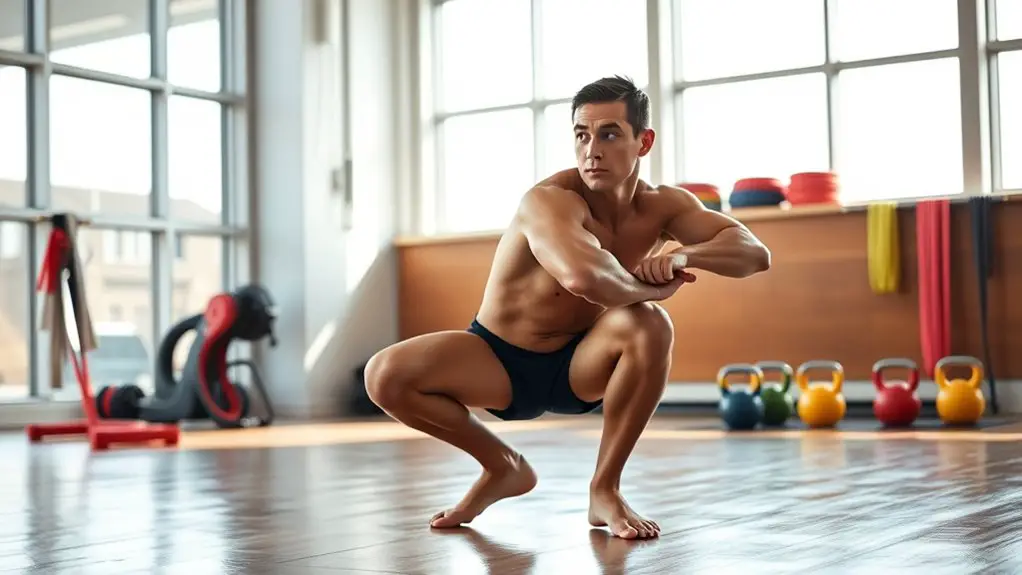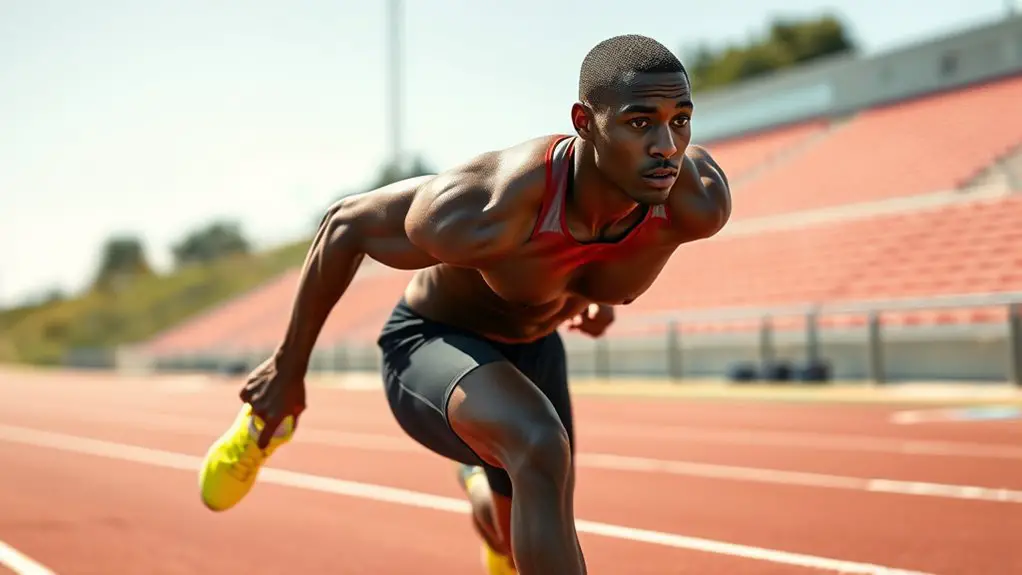To enhance your flip-turn speed, focus on strength training exercises like squats, deadlifts, and box jumps. Squats build leg strength for explosive push-offs, while deadlifts enhance core stability and power during turns. Box jumps improve your explosiveness and agility. Incorporate medicine ball slams for upper body strength, plus resistance band exercises to boost flexibility and control. These targeted workouts will elevate your performance and energy in the water—there's more to discover about optimizing your training!
Understanding the Importance of Flip-Turns
Understanding the importance of flip-turns is essential for any competitive swimmer, as they can greatly impact your race times. Mastering flip turn mechanics isn't just about speed; it's about fluidity and efficiency. When you nail your flip-turn technique, you minimize the time spent at the wall, giving you a significant competitive advantage.
Think about it: a well-executed flip-turn allows you to maintain your momentum, seamlessly shifting into your next lap. You'll conserve energy while maximizing speed, which means you can release your full potential in the water. Each flip-turn you perfect adds up, making a difference over the course of a race.
Embracing these turns as an integral part of your routine not only enhances your performance but also brings a sense of freedom in the water, allowing you to focus on the thrill of racing. Additionally, developing core strength can significantly improve your flip-turn efficiency and overall athletic performance. So, immerse yourself and refine those flip-turns; your future self will thank you.
Key Muscle Groups Involved in Flip-Turns
When you perform a flip-turn, several key muscle groups come into play, making your movement efficient and powerful. Understanding these muscle activations is essential for mastering flip turn mechanics.
| Muscle Group | Role in Flip-Turn | Importance for Speed |
|---|---|---|
| Core | Stabilizes body during rotation | Maintains balance and control |
| Quadriceps | Power during the push-off | Propels you off the wall |
| Hamstrings | Assists in leg positioning | Enhances rotation speed |
| Shoulders | Supports arm movement and alignment | Aids in streamlined entry |
Incorporating exercises like squats can significantly enhance the strength of these muscle groups, further improving your flip-turn efficiency.
Squats: Building Leg Strength for Explosive Push-Offs
Squats are a vital exercise for enhancing your leg strength, which directly impacts your flip-turn push-offs. When you master proper squat technique, you'll maximize your explosive power in the water. Plus, experimenting with different squat variations can further boost your strength and performance. Additionally, incorporating plyometric exercises into your training regimen can elevate your overall athletic performance.
Benefits of Squats
One of the most effective exercises for enhancing your flip-turn speed is the squat, which plays an essential role in building leg strength for explosive push-offs. By incorporating squat variations like front squats and jump squats into your routine, you can target different muscle groups, improving overall power and stability. The squat benefits go beyond just strength; they boost your core stability, enhance balance, and improve flexibility, all of which are significant for a smooth flip-turn. Additionally, you'll notice increased endurance, allowing you to maintain speed throughout your race. Embracing squats in your training not only prepares your body for the demands of swimming but also gives you the freedom to push your limits and achieve your goals.
Proper Squat Technique
Mastering proper squat technique is essential for maximizing leg strength and ensuring explosive push-offs during your flip-turns. Start by standing with your feet shoulder-width apart, engaging your core. As you lower into the squat, focus on achieving proper squat depth—aim for thighs parallel to the ground, keeping your chest up and knees aligned with your toes. Avoid letting your knees cave inward. You can incorporate squat variations, like goblet squats or sumo squats, to challenge your muscles differently while maintaining form. Remember to drive through your heels as you rise, activating those powerful leg muscles. With consistent practice, you'll notice improved strength, translating to faster, more efficient flip-turns. Enjoy the freedom that comes with better performance!
Variations for Strength
While traditional squats are effective, incorporating variations can greatly enhance your leg strength for explosive push-offs during flip-turns. By mixing in different exercise variations, you'll target multiple muscle groups and boost your overall power. Here are some fantastic options:
| Exercise Variation | Benefits |
|---|---|
| Jump Squats | Increases explosive power |
| Bulgarian Split Squats | Improves balance and strength |
| Goblet Squats | Enhances core stability and strength |
Integrating these into your strength training routine will not only make you stronger but also more agile in the water. So, embrace these variations, and watch your flip-turn speed soar. You've got the freedom to customize your workouts, so make them work for you!
Deadlifts: Enhancing Core Stability and Power
Deadlifts are a powerful tool for enhancing core stability and overall strength, making them essential for swimmers looking to improve their flip-turn speed. By incorporating deadlift variations into your routine, you can target different muscle groups while focusing on core engagement. Here's why you should include them:
Enhance your flip-turn speed and core stability by incorporating deadlifts into your training routine.
- Improved Core Stability: Strengthen your abs and lower back, vital for maintaining body position during turns.
- Increased Power: Develop explosive strength that translates directly to your flip-turn performance.
- Versatility: From conventional to sumo deadlifts, there's a variation for everyone.
In addition to improving your core and power, deadlifts also support joint health by enhancing the stability of key muscle groups involved in swimming. When you master these lifts, you'll feel more stable and powerful in the water. Plus, they'll help you maintain the freedom of movement you crave in your swimming. So, grab those weights and start deadlifting; your flip-turns will thank you!
Box Jumps: Improving Explosiveness and Agility
Box jumps are a fantastic way to boost your explosiveness and agility, essential for enhancing your flip-turn speed. With the right technique, you can maximize your performance while minimizing the risk of injury. Let's explore the benefits of box jumps and how to execute them properly. Additionally, incorporating plyometric exercises into your training can significantly improve your overall athletic performance.
Benefits of Box Jumps
Incorporating box jumps into your training regimen can greatly enhance your explosiveness and agility, both of which are essential for improving flip-turn speed in swimming. As a form of plyometric training, box jumps develop your fast-twitch muscle fibers, enabling you to spring off the wall with greater power.
- Boost your vertical leap, translating to quicker flip-turns.
- Improve your overall agility, helping you shift smoothly during races.
- Enhance your jump technique, ensuring efficiency in each movement.
These benefits not only elevate your performance in the pool but also give you the freedom to push your limits. Embrace the challenge, and you'll soon see how box jumps can transform your swimming experience.
Proper Jumping Technique
Mastering proper jumping technique is essential for maximizing the benefits of box jumps in your training. To enhance your vertical leap and overall explosiveness, focus on a few key elements. Start by positioning your feet shoulder-width apart and bend your knees slightly. When you jump, swing your arms upward and push through your heels, propelling yourself onto the box. Practice jumping drills regularly to refine your form and coordination. Land softly on the box with bent knees, absorbing the impact. This'll not only improve your agility but also reduce injury risk. Remember, consistency in your practice will lead to greater gains in your flip-turn speed. Embrace the freedom of movement, and watch your performance soar!
Medicine Ball Slams: Developing Upper Body Strength
While many athletes focus on swimming techniques for improving flip-turn speed, integrating medicine ball slams into your training regimen can greatly enhance your upper body strength. This dynamic exercise helps build explosive power, which is essential for your flip-turns. By mastering medicine ball techniques, you'll develop the upper body conditioning necessary to propel yourself efficiently off the wall.
- Increased explosive strength: Boost your power for quicker turns.
- Improved core stability: Strengthen your core to maintain form during flips.
- Enhanced shoulder mobility: Keep your shoulders flexible, reducing injury risk.
Incorporating these slams into your workout routine not only diversifies your training but also gives you that freedom to express strength in the water. So grab a medicine ball and start slamming your way to faster flip-turns! Remember, it's not just about swimming; it's about enhancing your overall performance. Additionally, these slams can also improve core stability, which is vital for maintaining control during flips.
Resistance Band Exercises: Focusing on Flexibility and Control
To improve your flip-turn speed, focusing on flexibility and control through resistance band exercises can make a significant difference. Resistance band stretches are fantastic for enhancing your range of motion, allowing you to execute those turns with grace and fluidity. Try incorporating lateral band walks to target your hip flexors and improve stability.
Additionally, consider integrating flexibility drills like banded shoulder stretches, which will help you maintain a streamlined position during your flip-turn. These exercises not only promote flexibility but also build control over your movements, ensuring you can pivot quickly and efficiently. This training approach can significantly contribute to injury prevention and rehabilitation, allowing you to develop strength while minimizing the risk of injury.
As you embrace these resistance band exercises, you'll notice increased mobility, which translates to faster, more effective flip-turns in the water. Prioritize these workouts in your training routine, and enjoy the newfound freedom and speed they bring to your swimming experience.
Incorporating Strength Training Into Your Swim Routine
Incorporating strength training into your swim routine can greatly enhance your overall performance, especially when it comes to executing flip-turns. By blending strength work with your regular swim drills, you'll build the power and agility needed to improve your technique.
- Focus on compound lifts like squats and deadlifts for overall strength.
- Integrate resistance band exercises to boost flexibility and control.
- Prioritize recovery techniques, such as foam rolling and stretching, to prevent injury.
- Additionally, incorporating functional mobility exercises will help improve your range of motion and stability during turns.
You don't have to spend hours in the gym. Just a couple of focused sessions each week can make a significant difference. Keep your workouts fun and varied, and watch as your flip-turn speed improves. With dedication and the right balance of strength training and swim drills, you'll unleash your potential in the water and feel a newfound sense of freedom in your performance.
Frequently Asked Questions
How Often Should I Perform Strength Training for Flip-Turns?
When considering how often you should perform strength training, think about your overall training schedules. Frequency guidelines suggest aiming for two to three sessions per week. This balance allows you to build strength while giving your body time to recover. It's all about finding what works for you, so feel free to adjust based on your energy levels and swimming commitments. Enjoy the process, and don't hesitate to mix things up to keep it engaging!
Can I Do These Exercises at Home?
Absolutely, you can do these exercises at home! A home workout offers the flexibility to fit your schedule. You don't need fancy exercise equipment; bodyweight exercises can be incredibly effective. If you want to add resistance, consider using items like resistance bands or dumbbells. This way, you can tailor your routine to your needs and still enhance your flip-turn speed. Enjoy the freedom of training on your own terms!
What Is the Best Warm-Up Before Strength Training?
They say, "An ounce of prevention is worth a pound of cure." Before you jump into strength training, start with dynamic stretches to get your muscles warm and ready. Incorporate movements like leg swings and arm circles to enhance flexibility and mobility. Don't forget foam rolling, either—it'll help release tension and improve your range of motion. A solid warm-up not only prepares your body but also sets the tone for a powerful workout!
Should I Consult a Coach Before Starting?
You should definitely consider consulting a coach before starting. The benefits of coaching are immense; a good coach can tailor your training to fit your needs and help you avoid injuries. When selecting a coach, look for someone who understands your goals and values your freedom in training. They can provide personalized guidance, making your journey more effective and enjoyable. Plus, having that support can keep you motivated and accountable along the way.
Are There Any Specific Nutrition Tips for Swimmers?
You might think that nutrition's just about eating right, but it's a game-changer for swimmers. Carbohydrate timing is essential; fueling up before and replenishing after workouts can boost your performance. Don't forget hydration strategies—staying hydrated helps you maintain energy and focus. So, aim for water during training and consider electrolytes for longer sessions. Embracing these tips will give you the freedom to push your limits in the pool and enhance your overall experience.




